Top 10 Best Coolers of 2024: Ultimate Guide and Reviews
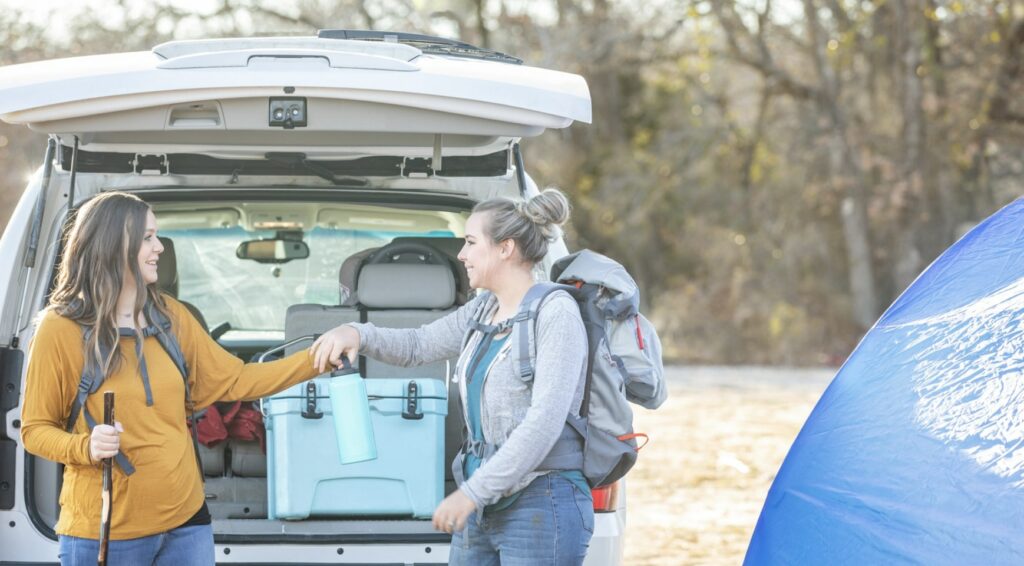
Are you ready to take your outdoor adventures to the next level in 2024? Then you’re in the right place! We all know that the only thing better than an epic outing is an epic outing with ice-cold refreshments. But not every cooler can withstand the rigors of the great outdoors and keep your drinks frosty at the same time. That’s why we’ve put together the ultimate list of the best coolers of 2024, so you can focus on planning your next adventure instead of worrying about warm beer.
Let’s face it, nobody wants to reach into a cooler expecting a chilly beverage and getting a lukewarm disappointment. It’s like expecting a high-five and getting a fist bump instead – a total letdown. But don’t worry, we’ve got your back (and your beverages). Our list of top coolers is your secret weapon against the outdoor heat, ensuring your drinks stay as cool as you are.
The coolers we’ll be sharing with you today aren’t just any coolers; they’re the supercars of the cooler world. These coolers are so cool, they make the Arctic look like a hot tub. Not only are they packed with features that make them highly efficient, but they’re also durable and practical. Plus, they come in all shapes and sizes, so there’s a perfect cooler for every adventurer out there.
So grab a cold one, sit back, and let’s dive into the world of coolers. By the end of this post, you’ll not only know what the best coolers of 2024 are, but you’ll also be itching to get your hands on one. Remember, the only thing worse than a warm drink is not having a cooler to blame it on.
What Are the Best Coolers of 2024?
When it comes to choosing a cooler, there’s more to consider than just how cold it can keep your drinks. You want a cooler that’s durable, portable, and able to withstand whatever Mother Nature has in store. It’s like choosing a hiking boot – it needs to fit just right and be tough enough to handle rocky terrain.
Here’s the thing. Not all coolers are created equal. Some are like loyal golden retrievers, always reliable and ready to serve. Others are more like a moody cat, only working when they feel like it. That’s why it’s crucial to choose a cooler that fits your needs, whether you’re an occasional picnicker or a hardcore camper.
But don’t be overwhelmed. We promise, finding the right cooler doesn’t have to be a wild goose chase. It’s not like trying to find a parking spot at the mall during the holiday season. With a little guidance and the right information, you’ll be able to navigate the cooler market like a pro. So, let’s get started and find the ideal cooler that will make your 2024 adventures unforgettable.
1. Yeti Tundra 65 Cooler
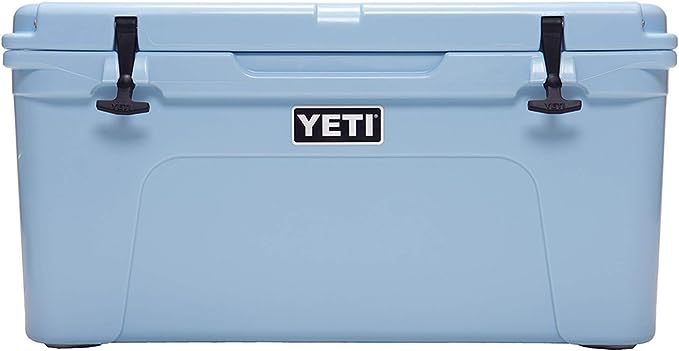
The Yeti Tundra 65 Cooler is the embodiment of rugged elegance. Serving as a quintessential companion for outdoor enthusiasts, this cooler is renowned for its exceptional durability and ice retention capabilities. The Yeti Tundra 65 is the perfect ally for your camping trips, fishing expeditions, or even backyard barbecues.
Going into more detail, the Yeti Tundra 65 Cooler features a rotomolded construction – a design technique used to ensure extreme durability and longevity. This cooler also boasts PermaFrost insulation, which provides maximum ice retention, keeping your goods cold for up to 7 days. With added features like the FatWall design and NeverFail hinges, this Yeti cooler is a true powerhouse.
Specifications
- Construction: Rotomolded
- Insulation: PermaFrost, max retention up to 7 days
- Features: FatWall design, NeverFail hinges, AnchorPoint tie-down slots, dry goods rack
- Dimensions: 30 1⁄2” L x 17 1⁄2” W x 16” H
- Weight: 29 lbs
- Capacity: 39 liters
| Pros | Cons |
| – Highly Durable – Exceptional ice retention – Convenient features like dry goods rack | – Higher price point – Somewhat heavy |
2. Pelican Elite Cooler
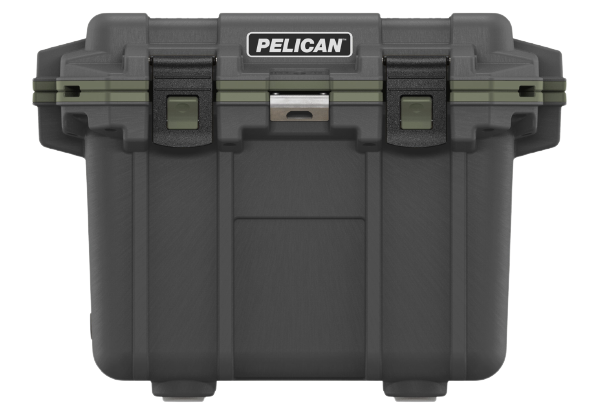
The Pelican Elite Cooler is the juggernaut of outdoor coolers, offering an unbeatable blend of durability and cooling prowess. Known for their legendary toughness, Pelican coolers are built to withstand even the harshest of outdoor conditions, making this cooler a valuable asset for any avid adventurer.
Delving deeper, the Pelican Elite Cooler showcases a rotomolded construction, ensuring it’s as sturdy as it is functional. Its exceptional ice retention capabilities, courtesy of the freezer-grade gasket, surpasses many competitors, promising up to 10 days of ice-cold refreshments. The press-and-pull latches and molded-in handles enhance its usability, but the cooler’s weight might be a drawback for some.
Specifications
- Construction: Rotomolded
- Ice Retention: Up to 10 days
- Features: Freezer-grade gasket, press-and-pull latches, molded-in handles
- Dimensions: 36” L x 20” W x 20” H
- Weight: 48 lbs
- Capacity: 70 liters
| Pros | Cons |
| – Exceptional ice retention – Highly durable – Convenient latches and handles | – Heavy and pricey |
3. Coleman Xtreme 5 Cooler
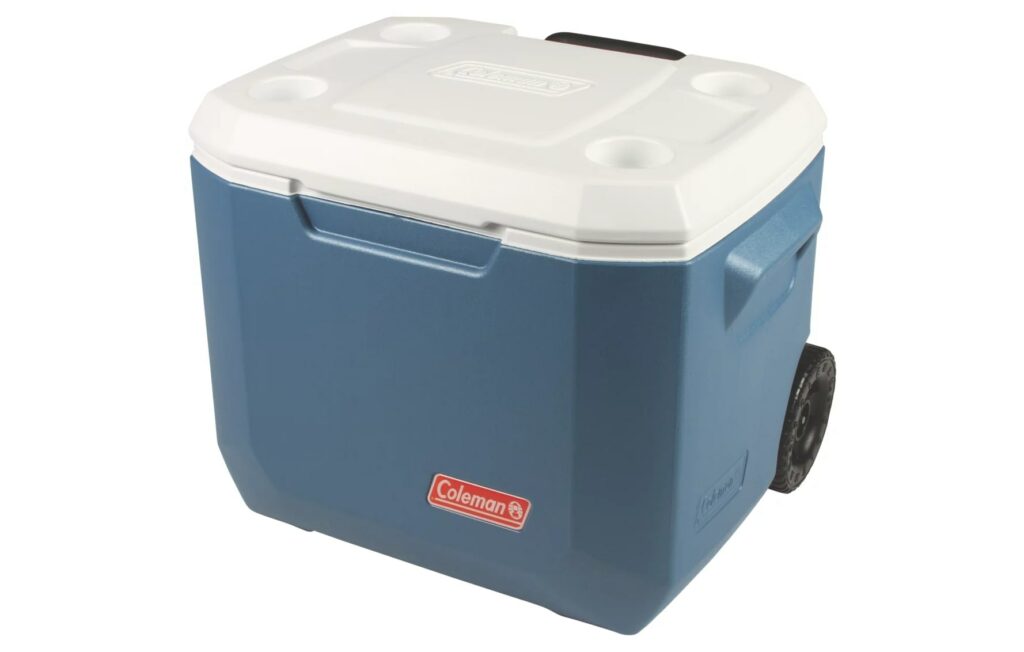
The Coleman Xtreme 5 Cooler is the ideal pick for those seeking a balance between affordability and functionality. This cooler is a popular choice for casual outings and weekend getaways, thanks to its practical design and impressive cooling abilities.
In terms of specifics, the Coleman Xtreme 5 Cooler features an insulated lid and body that help keep ice for 3 to 5 days. It also has a leak-resistant drain, allowing for easy draining of excess water. Despite its budget-friendly price, this cooler does not compromise on convenience, offering sturdy hinges and handles for easy mobility.
Specifications
- Insulation: Insulated lid and body
- Ice Retention: 3 to 5 days
- Features: Leak-resistant drain, hinges and handles
- Dimensions: 26.4” L x 17” W x 17.4” H
- Weight: 11.9 lbs
- Capacity: 70 liters
| Pros | Cons |
| – Budget-friendly – Decent ice retention – Easy to transport | – Ice retention lesser than high-end coolers |
4. Igloo Yukon Cold Locker Cooler
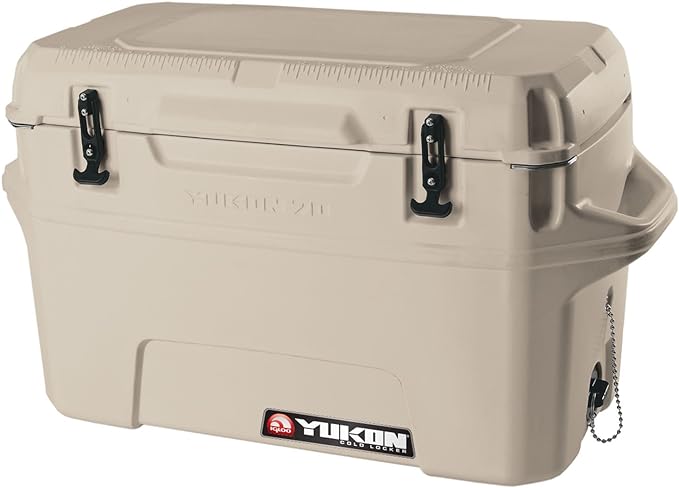
Igloo Yukon Cold Locker Cooler is a reliable workhorse that offers impressive cooling capabilities. Designed for serious outdoor enthusiasts, this cooler offers the perfect combination of durability and performance, making it an excellent choice for extended trips.
The Igloo Yukon Cold Locker Cooler is a rotomolded cooler offering PermaFrost insulation that promises up to 7 days of ice retention. It also features an integrated fish ruler and tie-down points, making it a great choice for fishing trips. The reversible skid-resistant feet add to its practicality, but it is quite heavy when loaded.
Specifications
- Construction: Rotomolded
- Insulation: PermaFrost, max retention up to 7 days
- Features: Integrated fish ruler, tie-down points, reversible skid-resistant feet
- Dimensions: 36 5⁄8” L x 17 1⁄4” W x 17 3⁄4” H
- Weight: 32 lbs
- Capacity: 70 liters
| Pros | Cons |
| – Great ice retention – Practical features – High-quality construction | – Heavy when loaded |
5. Canyon Cooler Outfitter Series
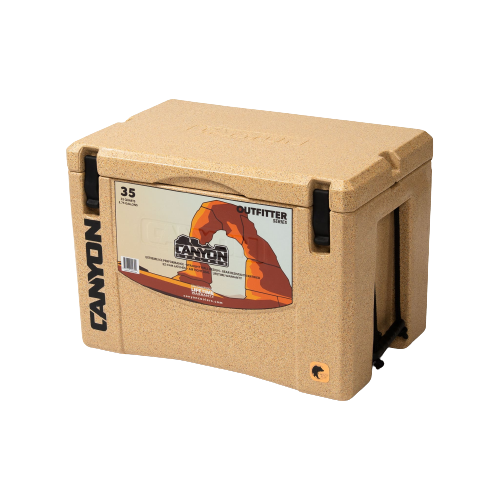
Compact, lightweight, and powerful, the Canyon Cooler Outfitter Series is perfect for those who value portability without compromising on ice retention. This cooler is a high-end product that offers excellent value for money, making it a favorite among adventurous spirits.
This cooler features rotomolded construction and offers up to 7 days of ice retention. Its marine-grade rope handles and non-skid feet make it easy to transport and stable in various conditions. Despite its compact size, this cooler is big on performance but falls short on capacity.
Specifications
- Construction: Rotomolded
- Ice Retention: Up to 7 days
- Features: Marine-grade rope handles, non-skid feet
- Dimensions: 22” L x 14” W x 18” H
- Weight: 22 lbs
- Capacity: 35 liters
| Pros | Cons |
| – Lightweight – Excellent ice retention – Affordable high-end cooler | – Smaller capacity |
6. Grizzly Cooler
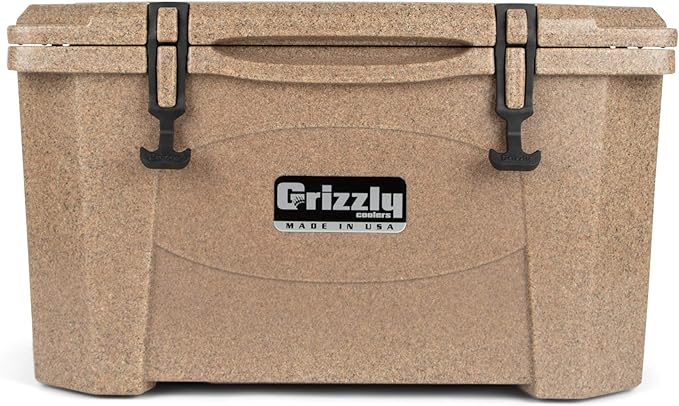
The Grizzly Cooler is the epitome of strength and durability. It is a high-quality cooler that provides excellent performance while withstanding the toughest conditions. Known for its robustness and ice retention capabilities, the Grizzly Cooler is a worthwhile investment for any outdoor enthusiast.
This cooler features a rotomolded construction and can retain ice for up to 7 days. It’s designed with rubberized feet for stability and an embossed ruler on the lid for convenience, especially for fishing enthusiasts. Despite its superior quality, it comes with a higher price tag for its size.
Specifications
- Construction: Rotomolded
- Ice Retention: Up to 7 days
- Features: Rubberized feet, embossed ruler on lid
- Dimensions: 25” L x 16” W x 15” H
- Weight: 23 lbs
- Capacity: 40 liters
| Pros | Cons |
| – High-quality construction – Excellent ice retention – Convenient features | – Pricey for its size |
7. Engel DeepBlue Cooler
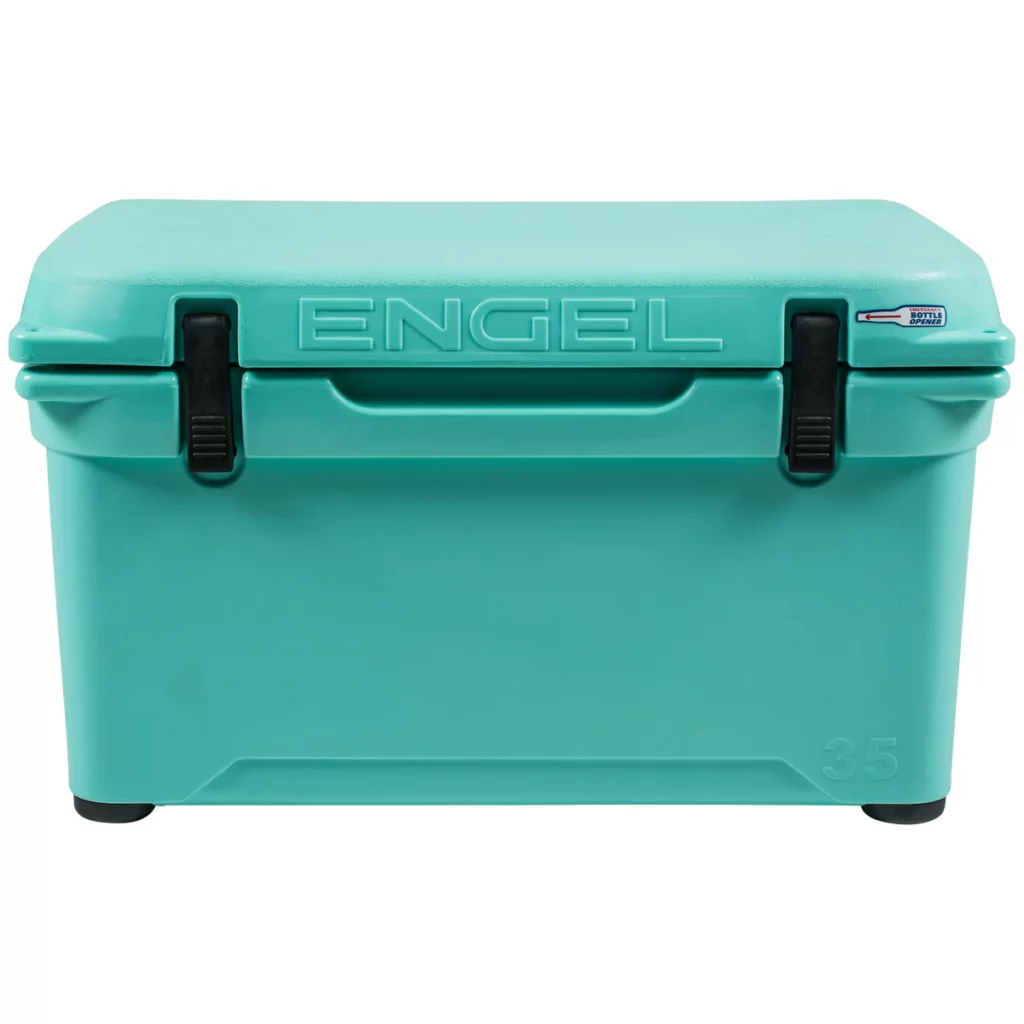
The Engel DeepBlue Cooler is a high-performance, top-tier cooler designed for serious outdoor enthusiasts. It’s known for its incredible ice retention capabilities and robust construction, setting the bar high for other coolers.
The Engel DeepBlue Cooler features an injection-molded construction and offers up to 10 days of ice retention, thanks to its 2″ insulation and airtight EVA gasket. Other features include recessed handles and padlock slots for added security. Its high-performance attributes are impressive but come with a steeper price tag.
Specifications
- Construction: Injection molded
- Ice Retention: Up to 10 days
- Features: 2” insulation, airtight EVA gasket, recessed handles, padlock slots
- Dimensions: 32” L x 20” W x 18.5” H
- Weight: 42 lbs
- Capacity: 83 liters
| Pros | Cons |
| – Superior ice retention – Robust construction – Secure and convenient features | – Very Expensive |
8. Yeti Roadie 24 Cooler
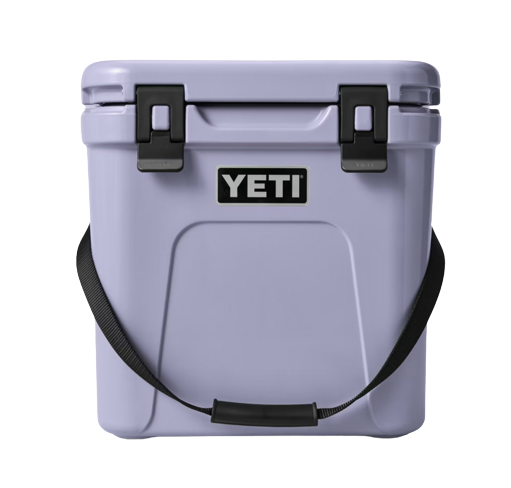
The Yeti Roadie 24 Cooler is a compact, portable cooler designed for personal use. Despite its smaller size, the Roadie 24 doesn’t compromise on performance, making it an excellent choice for day trips, road trips, or any outdoor adventure.
The Yeti Roadie 24 Cooler features rotomolded construction and PermaFrost insulation, which provides impressive ice retention. Its compact size and lightweight design make it easy to carry, while the NeverFail hinges ensure longevity. Despite its smaller capacity, the Roadie 24 offers notable performance.
Specifications
- Construction: Rotomolded
- Insulation: PermaFrost
- Features: NeverFail hinges
- Dimensions: 17 1/2” L x 16 1/2” W x 15 1/2” H
- Weight: 12.8 lbs
- Capacity: 18 liters
| Pros | Cons |
| – Compact and Portable – Excellent ice retention – Durable construction | – Smaller capacity |
9. RTIC Cooler
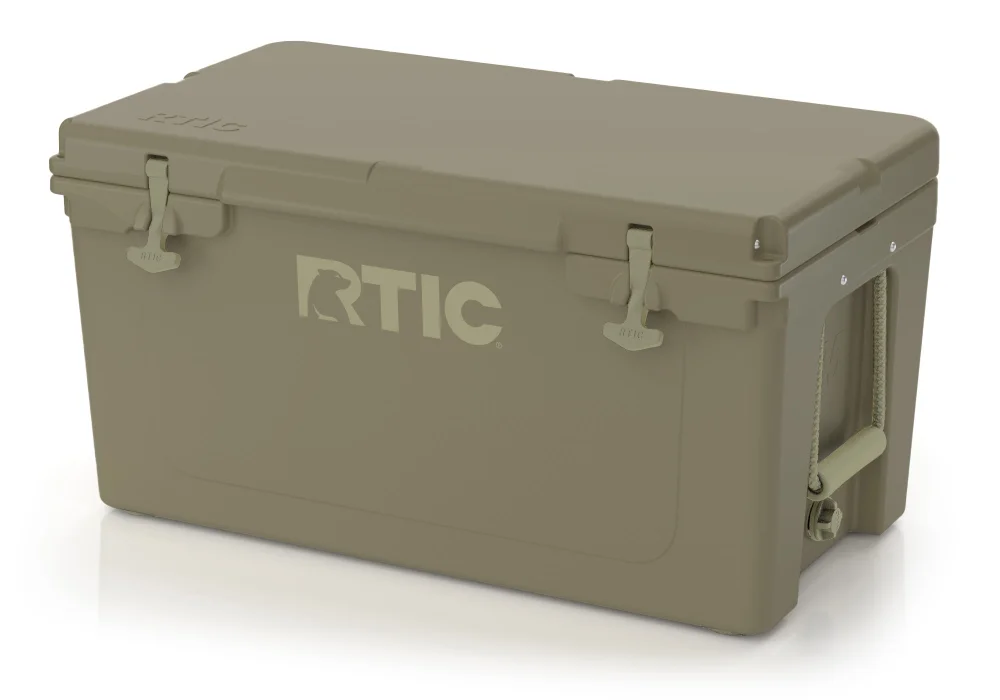
The RTIC Cooler is a reliable and efficient cooler that offers excellent performance at a reasonable price. Designed to keep your refreshments chilled for extended periods, this cooler is an excellent choice for a range of outdoor activities.
The RTIC Cooler features rotomolded construction and offers impressive ice retention capabilities. It includes heavy-duty rubber T-latches for secure closure and a built-in stainless steel handle for easy transport. Although it offers great value, it lacks some features found in more expensive models.
Specifications
- Construction: Rotomolded
- Ice Retention: Up to 7 days
- Features: Heavy-duty rubber T-latches, built-in stainless steel handle
- Dimensions: 24” L x 15” W x 15” H
- Weight: 23.5 lbs
- Capacity: 37 liters
| Pros | Cons |
| – Great value for money – Excellent ice retention – Sturdy construction | – Lacks some features of high-end coolers |
10. Orca Cooler
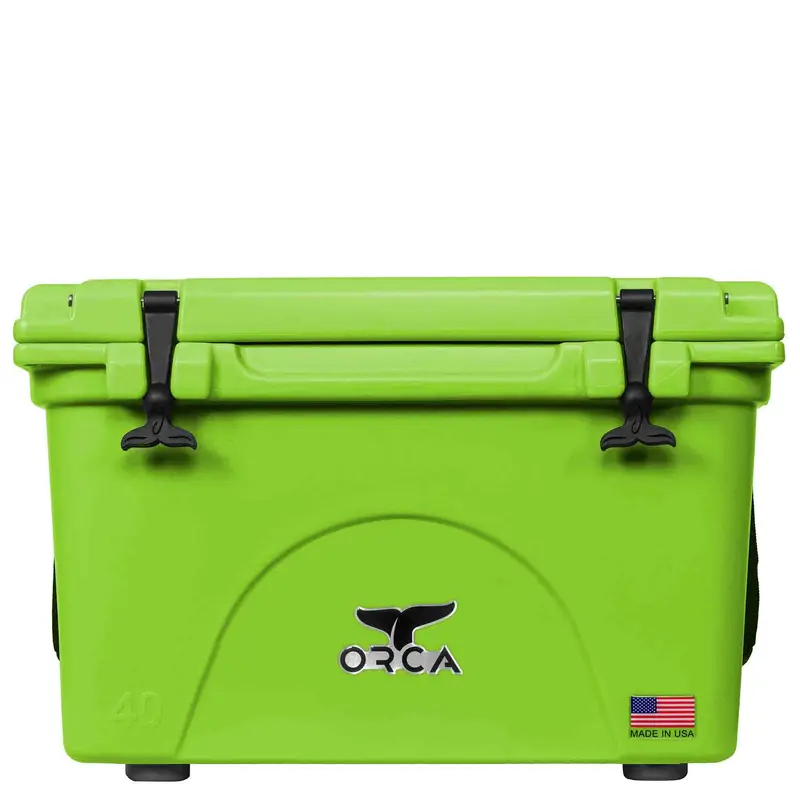
The Orca Cooler is a high-performance cooler designed to withstand the rigors of outdoor activities. Known for its durability and superior ice retention capabilities, the Orca Cooler is a favorite among adventurers who demand the best.
The Orca Cooler features rotomolded construction and offers up to 7 days of ice retention. It’s designed with a cargo net attachment for added storage and extendable flex-grip handles for easy transportation. While it offers top-tier performance, it also comes with a high price tag.
Specifications
- Construction: Rotomolded
- Ice Retention: Up to 7 days
- Features: Cargo net attachment, extendable flex-grip handles
- Dimensions: 27” L x 17.5” W x 17.5” H
- Weight: 26 lbs
- Capacity: 58 liters
| Pros | Cons |
| – Superior ice retention – Durable construction – Convenient features | – High price point |
Camping Coolers Buying Advice
Comparing Cooler Build Techniques: Rotomolding vs. Injection Molding
Understanding cooler construction can be a game-changer when it comes to choosing the right cooler for your needs. The two primary methods used in cooler construction are rotomolding and injection molding.
Rotomolding, short for rotational molding, involves a heated hollow mold that’s filled with a material — usually a plastic powder. This mold is slowly rotated, causing the softened material to disperse and stick to the walls of the mold. The result? A highly durable, uniform structure with no seams or weak spots, making it ideal for rough and tumble outdoor adventures.
On the other hand, injection molding involves injecting molten plastic into a mold under high pressure. This process is often cheaper and more common, making it a go-to method for many cooler manufacturers. Injection molded coolers, while not as sturdy as their rotomolded counterparts, are often lighter and more budget-friendly.
Both methods have their unique benefits. If durability and insulation are your top priorities — perhaps you’re an avid camper who often finds themselves in rugged conditions — a rotomolded cooler might be your best bet. However, if weight and cost are more important to you — say, you’re a casual hiker who prefers short trips — an injection molded cooler could serve you well.
Different brands use different methods, and this can significantly impact a product’s performance and price. For example, high-end brands like Yeti and Orca use rotomolding for their coolers, leading to excellent performance but also a higher price tag. On the other hand, brands like Coleman and Igloo often opt for injection molding, resulting in more affordable but less robust coolers.
Remember, the best cooler is the one that fits your specific needs and budget. Understanding the difference between rotomolding and injection molding can make all the difference in your coolers buying experience, ensuring you get the most bang for your buck.
Cooler Sizes: Finding Your Perfect Match
As we move from the construction aspect of coolers, let’s delve into another significant factor that plays a crucial role while making a purchase decision – the size of the cooler. Coolers come in a plethora of sizes, from small personal coolers that are perfect for a day trip to the beach, to large, heavy-duty coolers designed to sustain extended camping trips in the wilderness.
The size of a cooler directly impacts three key things: capacity, portability, and ice retention capabilities. Let’s break these down:
- Capacity: Capacity is a measure of how much a cooler can hold. It is typically measured in quarts. A quart is roughly equivalent to a liter, so a 50-quart cooler can hold about 50 liters. In practical terms, this roughly equates to around 48 cans, assuming a 1:1 ratio of ice to cans. But remember, this is a rough estimate and can vary based on the cooler’s design and your packing style.
- Portability: Naturally, the size of the cooler affects its portability. A smaller cooler is easier to carry around, making it ideal for day trips or solo travelers. A larger cooler, while offering more capacity, can be more challenging to transport, especially when filled to the brim.
- Ice Retention: Size also affects a cooler’s ice retention capabilities. Larger coolers generally have better ice retention because there’s more space for ice, and it takes longer for the heat to penetrate. But keep in mind, the quality of construction and insulation also plays a significant role in ice retention.
So, how do you choose the right size? Start by asking yourself some questions. How many people will the cooler need to serve? What is the length of your trip? What types of items will you be storing?
If you’re going on a short day trip with a small group, a personal cooler around 20-30 quarts might be sufficient. However, for a week-long camping trip with a large family, you might need a heavy-duty cooler of 70 quarts or more.
Choosing the right size cooler is a balancing act between your needs and the cooler’s capacity, portability, and ice retention capabilities. With the right coolers buying advice and a clear understanding of your requirements, you’ll be well on your way to finding the perfect cooler for your next adventure.
Ice Retention and Cooling Capabilities: A Deep Dive into Your Cooler’s Performance
Transitioning from the size and capacity of coolers, let’s focus on a feature that’s equally, if not more, important – ice retention and cooling capabilities. This feature is undoubtedly a deal-breaker for many outdoor enthusiasts. After all, who wants a cooler that can’t keep your drinks cold and your food fresh?
Several factors contribute to a cooler’s ice retention abilities. These include:
- Insulation Type and Thickness: The insulation material and its thickness significantly impact how well a cooler can retain ice. High-end coolers often utilize premium insulation materials and thicker walls to enhance ice retention. In contrast, budget coolers may skimp on insulation quality or thickness, resulting in shorter ice life.
- Lid Seal: A tight and secure lid seal is crucial in preventing warm air from entering and cold air from escaping the cooler. High-quality coolers usually feature robust lid seals, often rubber gaskets, to maintain an airtight environment.
- External Conditions: Lastly, ice retention is greatly influenced by the external environment. Factors such as ambient temperature, exposure to direct sunlight, and how often the cooler is opened can affect ice life.
Testing a cooler’s ice retention capabilities is straightforward. Simply fill the cooler with ice and monitor how long it takes for the ice to melt completely. Remember, to ensure a fair test, try to replicate the conditions in which the cooler will be used.
Now, you may wonder, why do some coolers keep ice for several days while others can only do so for a few hours? The answer lies in the factors we discussed above. High-end coolers, with superior insulation, robust lid seals, and durable construction, are designed to maximize ice retention. On the other hand, budget coolers, while affordable, may compromise on these features, resulting in shorter ice life.
The difference in cooling capabilities between high-end and budget coolers directly affects the freshness and safety of stored food and drinks. A cooler that can maintain low temperatures for extended periods can keep your food fresh and safe to consume for longer. On the contrary, a cooler with poor ice retention may cause the food to spoil, posing a risk to health and safety.
In your quest for coolers buying advice, remember that a cooler’s ice retention and cooling capabilities are critical. While budget coolers may be tempting, consider investing in a high-quality cooler if your adventures require prolonged ice retention. After all, the safety and freshness of your food and beverages are paramount, aren’t they?
Weight and Portability: Key Considerations for Outdoor Enthusiasts
Moving on from ice retention and cooling capabilities, another crucial consideration in your cooler buying journey is the weight and portability. For campers and hikers, a cooler’s weight can make or break the outdoor experience. After all, nobody wants to lug around a heavy cooler when exploring the great outdoors.
The size of the cooler, its construction material, and design all contribute to its weight. Larger coolers, naturally, weigh more. However, they offer more storage space, which can be a boon for longer trips. On the other hand, smaller coolers are lighter and more portable, but offer less storage space.
When it comes to construction material, hard-sided coolers are typically heavier than their soft-sided counterparts but offer more durability and better insulation. Materials like rotomolded plastic, commonly used in high-end coolers, are heavier but provide excellent ice retention and durability. Conversely, soft-sided coolers are lighter, thanks to the materials like nylon or vinyl. However, they might not offer the same level of insulation or durability as hard-sided coolers.
To enhance portability, many coolers come with features such as handles, straps, and even wheels. Handles and straps make carrying the cooler easier, and models with wheels offer the convenience of rolling the cooler instead of carrying it, which can be a lifesaver when navigating uneven terrains.
Comparing the weight and portability of hard-sided coolers and soft-sided coolers, it’s evident that soft-sided coolers are the winners in terms of weight and portability. They are easier to carry, especially over long distances, and are perfect for activities like picnicking, day-trips, or short hikes. However, for more extended trips or large groups, hard-sided coolers, despite being heavier, may be the better option due to their larger capacity and superior ice retention.
As you seek coolers buying advice, remember to consider your specific needs and preferences. If you prioritize lightweight and easy transportation, a soft-sided cooler might be your best bet. If you prefer longer ice retention and larger storage capacity, a hard-sided cooler could be a more suitable choice, even if it means dealing with a bit of extra weight. It’s all about finding the balance that works for you.
The Benefits and Challenges of Wheeled Coolers: Rolling Your Way Through Outdoor Adventures
Continuing on our journey of coolers buying advice, let’s shift our focus to wheeled or rolling coolers. Imagine you’re on a camping trip, and you have a cooler packed with beverages, food, ice packs, and maybe a few treats. The weight adds up quickly, and carrying the cooler from your vehicle to the campsite can be a strenuous task. That’s where wheeled coolers come to the rescue!
Wheeled coolers offer increased mobility and less strain on the user, making them an excellent choice for outdoor enthusiasts. The wheels make it easy to transport the cooler over short distances, such as from your car to the campsite, without having to lift the heavy load. Moreover, they’re a boon when you have a large amount of food and drinks to transport, reducing the physical strain and making your outdoor experience more enjoyable.
However, not all terrains are friendly to wheeled coolers. They perform best on paved or solid surfaces, where the wheels can roll smoothly. Campgrounds, parks, and picnic spots often have paved paths, making wheeled coolers a convenient choice.
On the flip side, wheeled coolers may face challenges on sandy or rocky terrains. The wheels, especially if they’re small or not designed for rugged landscapes, can get stuck in the sand or struggle on rocky, uneven grounds. If your outdoor adventures often take you to beaches or rough terrains, it’s worth considering a cooler with larger, all-terrain wheels or opting for a non-wheeled version and using a separate transport method like a trolley.
Despite the mobility advantages, wheeled coolers do come with some potential downsides. The addition of wheels and the associated hardware can add to the weight of the cooler. This might not be a concern when you’re rolling the cooler, but it does become noticeable if you need to lift it, such as when loading or unloading from your vehicle.
Furthermore, the durability of wheeled coolers can sometimes be a concern. The wheels and the handle mechanism are additional parts that can potentially break or malfunction, especially with rough use or over time. However, high-quality wheeled coolers are designed to withstand these stresses, and durability largely depends on the product’s quality and how it’s used and maintained.
So, what makes a high-quality wheeled cooler? Look for sturdy wheel and handle designs. Large, all-terrain wheels are generally better equipped to handle a variety of surfaces. The handle should be robust, comfortable to grip, and designed to control the cooler effectively. Some models feature telescopic handles that can be adjusted according to the user’s height, further enhancing the ease of use.
Bringing our discussion of wheeled coolers to a close, it’s clear that they can be a fantastic option for campers and hikers, easing the burden of transporting a loaded cooler. However, it’s crucial to consider the type of terrain you’ll be traversing and the potential trade-off in terms of increased weight and potential durability concerns. As always, your specific needs and preferences should guide your choice. Happy camping!
The Value Proposition of Expensive Coolers: A Worthy Investment or a Luxury Splurge?
One of the most common questions when considering coolers buying advice is, “Are expensive coolers worth it?” This question particularly resonates with our audience of campers and hikers who are always on the lookout for reliable, durable, and high-quality gear.
Expensive coolers often come with advanced features, superior durability, and better performance compared to cheaper alternatives. They are typically made from high-quality materials, have better insulation, and are designed to withstand harsh outdoor conditions. This often translates to longer ice retention periods, meaning your food and drinks stay cold for longer.
For instance, if you’re planning a week-long camping trip in the middle of summer, a high-end cooler might be the only one to guarantee your food stays fresh for the entire duration. Or, if you’re hiking in a particularly rugged terrain, a more expensive, robust cooler might be able to withstand the wear and tear better than a cheaper option.
Moreover, expensive coolers often come with extra features that enhance convenience and usability. These may include built-in bottle openers, fish rulers for the angling enthusiasts, cup holders, and even internal dividers for better organization of your food and drinks.
On the other hand, cheaper coolers can serve the purpose if your outdoor adventures are short, infrequent, or if you’re not too concerned about the cooler’s longevity. They can keep your food and drinks cool for a day or two and are typically lighter and easier to carry due to their simpler construction and materials.
It’s important to remember the old adage, ‘you get what you pay for’. This usually holds true in the realm of coolers. More expensive coolers offer better value in terms of features, durability, and performance. However, whether the extra cost is justified depends on your specific needs and circumstances.
If you frequently embark on outdoor trips, or if you need to store sensitive items that require a constant cool temperature, investing in an expensive cooler makes sense. It might seem like a hefty upfront cost, but the enhanced performance and longevity can save you money in the long run.
Conversely, if you’re an occasional camper or hiker, a cheaper cooler might suffice. It’s all about assessing your needs, preferences, and budget to make an informed decision.
In the world of coolers, just like with any other outdoor gear, understanding your needs is the key to choosing the right product. While expensive coolers offer clear advantages, it’s vital to consider your specific requirements before making a purchase. After all, the best cooler for you is one that serves your needs perfectly, whether it’s a high-end model or a budget-friendly one.
Securing the Cool: The Role of Latches and Gaskets in Cooler Efficacy
Venturing into the wild outdoors requires adequate preparation, and a central part of this preparation involves preserving your food and drinks. A cooler does precisely that, but have you ever thought about the role that latches and closure systems play in maintaining the cooler’s temperature? When considering coolers buying advice, these components are often overlooked, yet their contribution to the cooler’s overall performance is significant.
The latch and closure system of a cooler is its first line of defense. It ensures the cooler is sealed tight, preventing warm air from seeping in and cold air from escaping. Consequently, the cooler’s temperature is maintained, and your food and drinks remain chilled for extended periods. Moreover, a high-quality latch and closure system prevent spills, which is especially crucial during bumpy rides or if the cooler accidentally tips over.
Different brands use various types of latches in their coolers. Some opt for rubber T-latches, which are both sturdy and easy to use. They securely lock the cooler and are known to withstand frequent use without wearing out. On the other hand, some brands use integrated hinge systems, which offer a seamless design but may not be as durable as rubber T-latches.
Additionally, some brands use metal latches, known for their durability and strength. However, these may not be as flexible or easy to use as rubber T-latches. The choice between these latch types will depend on your specific needs and preferences. For instance, if you frequently use your cooler and need a latch that can withstand heavy use, a rubber T-latch or a metal latch would be ideal.
Let’s not forget the role of gaskets in enhancing a cooler’s insulation. A gasket is a type of seal, usually made from rubber, that ensures the cooler is airtight when closed. Gaskets work hand-in-hand with the latch and closure system to maintain the cooler’s temperature. By creating an airtight seal, gaskets prevent the exchange of warm and cold air, enhancing the cooler’s insulation.
In essence, the latch, closure system, and gasket are the unsung heroes in a cooler’s design. They work silently in the background to ensure your cooler performs optimally, keeping your food and drinks cold for longer. Therefore, when seeking coolers buying advice, don’t overlook these components. Their quality and design could make a world of difference in your outdoor adventures.
Bear-Resistant Ratings: The Unseen Essential for Wilderness Adventurers
In the wilderness, your cooler isn’t just facing the challenge of temperature control. A different kind of invader might be on the prowl—bears. If you’re an outdoors enthusiast frequenting bear-prone areas, you’d be wise to consider bear-resistant coolers. But what does this mean, and how does a cooler earn this badge of honor?
Bear-resistant coolers are designed to withstand the exploratory antics of these curious creatures. They are built with sturdy construction and complex locking mechanisms to keep the bears out and your food supply safe. While a bear might not resist the smell of your delicious camp food, a bear-resistant cooler ensures they can’t access it.
So, how does a cooler earn its bear-resistant stripes? It’s all about testing. A product receiving the bear-resistant certification has undergone rigorous testing by the Interagency Grizzly Bear Committee (IGBC). The IGBC’s testing protocol involves actual grizzlies. If a cooler can keep the food secure from these powerful creatures for an hour, it earns the bear-resistant certification.
Key features of bear-resistant coolers include:
- Sturdy Construction: These coolers are built to last with materials like heavy-duty plastic or metal. They are designed to withstand the force exerted by a bear and not give in easily.
- Complex Locking Mechanisms: A simple latch won’t do here. Bear-resistant coolers often feature complex locking systems that require opposable thumbs or a specific series of actions to open, which bears cannot execute.
- Tight Sealing Gaskets: These coolers have gaskets to provide an airtight seal, making it harder for the bear to smell the food inside and less likely to attempt breaking into the cooler.
- Rounded Edges and Handles: Bears leverage edges and handles to pry open coolers. By designing coolers with rounded edges and recessed handles, manufacturers make it difficult for bears to get a grip.
Remember, a bear-resistant cooler doesn’t just protect your food—it also plays a role in wildlife conservation. By keeping bears from accessing human food, these coolers help prevent bears from associating campgrounds with food, a habit that often leads to dangerous encounters and can result in the bear being euthanized.
So, when seeking coolers buying advice, consider the bear-resistant rating if you’re planning to camp in bear country. It’s not just about keeping your food cool and secure—it’s about keeping both you and the bears safe.
Mastering the Flow: The Importance of Cooler Drain Systems
Beyond the realm of bear-resistant features and robust construction, there lies a crucial yet often overlooked aspect of cooler design: the drain system. A well-designed drain system is vital for maintaining the longevity and efficiency of your cooler. It allows for easy cleaning and prevents water from diluting the ice, ensuring your food and drinks remain at the optimal temperature during your wilderness adventures.
The type of drain system can significantly impact a cooler’s performance. Some common types of drain systems found in coolers include:
- Screw Plug Drains: Mostly found in traditional coolers, these drain systems involve a simple plug that is screwed in and out to control the water flow. While these are simple to use, they can sometimes be prone to leakage if the plug is not properly sealed.
- Channel Drains: These systems are designed to direct the flow of water towards the drain, making for more efficient and effective draining. They are a bit more complex but generally provide better results compared to screw plug drains.
- Garden Hose Compatible Drains: A few high-end coolers offer this feature which allows for easy and mess-free draining by connecting a garden hose to the cooler. It’s a convenient feature for large coolers or when the cooler is used in a stationary position for an extended period.
Despite their benefits, drain systems are not without potential issues. Leakage is a common problem if the drain plug is not adequately sealed or if the cooler has been roughly used, leading to wear and tear. Blockages can also occur due to the accumulation of food particles or debris within the drain system. Regular cleaning and maintenance can help prevent these issues and ensure your cooler’s drain system functions at its best.
Remember, a well-functioning drain system not only makes your cooler easy to clean but also maintains the cooling efficiency by preventing ice dilution. So next time you seek coolers buying advice, don’t neglect the importance of the drain system. It might just be the difference between a soggy sandwich and a perfectly chilled beverage on your next camping or hiking trip.
Elevate Your Outdoor Experience: Essential Cooler Accessories and Add-Ons
Stepping up your cooler game goes beyond selecting the right size or the most durable material. It’s about optimizing your cooler’s functionality with the right accessories and add-ons. These extras can transform your cooler from a simple food storage unit into a multifunctional tool that enhances your outdoor experience.
Dividers: These accessories are perfect for those who like to keep things organized. Dividers help segment your cooler into separate spaces, allowing you to sort your food and drinks for easy access. Imagine being able to quickly grab your pre-made sandwiches without digging through a pile of icy cans.
Baskets: Baskets take organization one step further. They are great for keeping delicate or small items from getting squashed or lost at the bottom of your cooler. Items like fruits, cheese, or chocolate bars can be kept safe and easy to find in a basket.
Cushion Tops: For the savvy camper or hiker, a cooler isn’t just a storage unit; it’s also potential seating. Cushion tops transform your cooler into a comfortable seat, saving you the trouble of packing extra chairs. Plus, who wouldn’t enjoy a cold drink while resting their legs after a long hike?
Bottle Openers: It might seem like a small addition, but a built-in bottle opener can be a game-changer. No more rummaging through your backpack or trying to improvise with a rock. With a bottle opener on your cooler, cracking open a cold one becomes effortless.
While all these add-ons can enhance the usability and convenience of your cooler, it’s essential to consider your specific needs before investing. For instance, if most of your cooler contents are canned drinks, a divider might not be necessary. Similarly, if you usually bring foldable chairs for your outdoor trips, a cushion top could be an unnecessary expense.
When it comes to cooler accessories, the best advice is to choose what genuinely adds value to your camping or hiking experience. After all, the goal is not just to carry your food and drinks, but to make your outdoor adventures more enjoyable.
Navigating Ice Types: Crushed, Blocks, Packs, or Dry
Selecting the right type of ice can greatly impact your cooler’s performance. Each variant presents unique attributes affecting both the cooling efficiency and the ice retention time of your cooler. Let’s delve into the characteristics of these four ice types: crushed, blocks, packs, and dry.
Crushed Ice: This is your everyday ice cube. Ideal for quickly chilling your drinks, crushed ice is a popular choice for short day trips. It molds easily around items, ensuring even cooling. However, the downside includes a shorter retention time due to its small size.
Block Ice: If you’re planning a longer trip, block ice is a great option. Its larger size ensures it melts slower than crushed ice, extending the cooling duration of your cooler. Bear in mind, though, that due to its size, it can take up more space and might not cool items as quickly as crushed ice.
Ice Packs: These are perfect for those who want a no-mess solution. Ice packs can be frozen ahead of time and reused, eliminating the need for constantly buying ice. They are also relatively easy to pack and take up less space compared to block ice. The only drawback is they might not offer the same cooling power as traditional ice.
Dry Ice: When you need maximum cooling for extended periods, dry ice is your best bet. It’s the coldest type of ice available and doesn’t leave any water residue as it evaporates instead of melting. However, safety precautions must be taken when using dry ice due to its extreme cold temperature.
As a savvy camper or hiker, your choice of ice should align with your specific needs. Crushed ice may be ideal for a quick chill on a day trip, while block ice is better for prolonged cooling during multi-day adventures. Ice packs offer convenience and reusability, whereas dry ice provides the most intense cooling for extended periods. With this coolers buying advice, you can make a well-informed decision to suit your outdoor excursion.
Making Sense of Cooler Warranties: A Guide to Confidence in Your Purchase
When it comes to buying a cooler, one factor that often gets overlooked is the warranty. Yet, it remains an essential part of your coolers buying advice. Not all warranties are created equal, and understanding what’s covered can be a significant indicator of the cooler’s quality and durability.
A good warranty is a manufacturer’s vote of confidence in their product. It’s an assurance that they stand behind the quality and durability of their cooler, and are ready to address any defects or malfunctions that may occur. But how do we navigate the often complex language of warranties? Let’s break it down.
Typical Cooler Warranty Coverage
In most cases, a cooler warranty will cover defects in materials and workmanship. This means if your cooler has a manufacturing defect or if something breaks down under normal use, the manufacturer will repair or replace it at no cost to you. However, it’s important to note that most warranties do not cover damages resulting from misuse, neglect, or normal wear and tear.
Comparing Warranty Policies
Warranty policies can significantly vary from one brand to another. Some offer a limited one-year warranty, while others might offer a lifetime warranty. The length of the warranty can also be a reflection of the brand’s trust in their product. A longer warranty likely represents a higher level of confidence in the cooler’s durability and performance.
Be aware, however, that a “lifetime warranty” doesn’t always mean the cooler’s entire lifespan. Often, “lifetime” refers to the lifetime of the product as determined by the manufacturer, which could be as short as five years. Always read the fine print!
Warranty as an Indicator of Quality
A robust warranty policy reveals a lot about the cooler’s quality. Brands willing to cover their products for an extended period are usually more confident in their product durability. This can serve as a peace of mind for you as a consumer, knowing that your investment is well protected.
Ultimately, a warranty is your safety net when purchasing a cooler. It’s not just about what happens if something goes wrong; it’s about the manufacturer’s commitment to ensuring you have a cooler that lasts, performs, and meets your expectations. So next time you’re comparing coolers, take a moment to consider the warranty. It might end up being the deciding factor in your purchase.
Hard-Sided vs. Soft-Sided Coolers: A Guide to Making the Right Choice for Your Outdoor Adventures
When it comes to coolers, the dilemma often revolves around choosing between hard-sided and soft-sided variants. Your choice depends on various factors, including your specific needs, the nature of your outdoor activities, and your personal preferences. Here’s a comparison of the two types of coolers to help inform your buying decision.
Construction
Hard-sided coolers, as the name suggests, are built with rigid materials, usually plastic. Their sturdy construction makes them perfect for rugged outdoor activities. They can withstand being banged around in the back of a truck or being used as an impromptu seat at a campsite.
On the other hand, soft-sided coolers are made from flexible materials such as vinyl or fabric. They come with a reinforced hard liner inside to maintain their shape and protect the contents. This design makes them more lightweight and compact, ideal for activities that require mobility, such as hiking or picnicking.
Portability
In terms of portability, soft-sided coolers take the lead. They are lighter and often come with shoulder straps or handles for easy transport. This makes them perfect for short trips or situations where you’ll be carrying the cooler for extended periods.
Hard-sided coolers, due to their bulk and weight, are less portable. However, many models come with wheels and handles to facilitate movement. They are best suited for car camping, tailgating, or other activities where they’ll stay in one place for a while.
Capacity and Insulation
Hard-sided coolers generally offer larger capacities, making them ideal for long camping trips or large gatherings. They also provide superior insulation, keeping your food and drinks cold for several days.
Soft-sided coolers, while smaller, can still hold enough food and drinks for a day trip. Their insulation capabilities, though not as strong as hard-sided coolers, are sufficient for keeping items cold for a few hours to a day.
Durability and Maintenance
Both types of coolers have their strengths when it comes to durability. Hard-sided coolers can take a beating and last for many years. They are also easier to clean, thanks to their smooth interior surface.
Soft-sided coolers, while not as rugged, are designed to withstand regular use. They may require a bit more effort to clean, especially if a spill occurs inside.
In conclusion, the choice between a hard-sided and soft-sided cooler ultimately depends on your specific needs and the nature of your outdoor activities. Consider the aspects of construction, portability, capacity, insulation, durability, and maintenance. By understanding these differences, you’ll be better equipped to choose the cooler that best fits your outdoor needs.
Comparison of Products
| Cooler | Weight | Capacity | Ice Retention | Notable Features |
|---|---|---|---|---|
| Yeti Tundra 65 | 29 lbs | 39 liters | Up to 7 days | PermaFrost insulation, FatWall design |
| Pelican Elite | 48 lbs | 70 liters | Up to 10 days | Freezer-grade gasket, press-and-pull latches |
| Coleman Xtreme 5 | 11.9 lbs | 70 liters | 3-5 days | Insulated lid and body, leak-resistant drain |
| Igloo Yukon Cold Locker | 32 lbs | 70 liters | Up to 7 days | Integrated fish ruler, tie-down points |
| Canyon Cooler Outfitter Series | 22 lbs | 35 liters | Up to 7 days | Marine-grade rope handles, non-skid feet |
| Grizzly Cooler | 23 lbs | 40 liters | Up to 7 days | Rubberized feet, embossed ruler on lid |
| Engel DeepBlue | 42 lbs | 83 liters | Up to 10 days | 2” insulation, airtight EVA gasket |
| Yeti Roadie 24 | 12.8 lbs | 18 liters | Varies | NeverFail hinges |
| RTIC Cooler | 23.5 lbs | 37 liters | Up to 7 days | Heavy-duty rubber T-latches |
| Orca Cooler | 26 lbs | 58 liters | Up to 7 days | Cargo net attachment, extendable flex-grip handles |
Conclusion
And there you have it, adventurers – your ultimate guide to the best coolers of 2024! It’s been a wild ride, like white water rafting in the Grand Canyon or scaling Everest, but we made it.
If you’re still reading this, congratulations! You now have more knowledge about coolers than most people have about their own cellphones. You’re officially a cooler guru, ready to drop knowledge bombs at your next social gathering or leave mind-blowing reviews on outdoor forums.
But why should you trust our cooler wisdom? Well, not to toot our own horn (okay, maybe just a little), we’re pretty seasoned when it comes to outdoor gear. Our team has spent countless hours researching, testing, and debating the merits of various coolers to provide you with the most accurate, comprehensive guide possible.
But remember, just like trying to pet a grizzly bear, choosing the wrong cooler can be a disastrous mistake. But unlike the grizzly scenario, we’ve got you covered in the cooler department.
So whether you’re planning a week-long camping trip or just a weekend BBQ, remember that having the right cooler can turn a good experience into a great one. Because life’s too short for warm beer and soggy sandwiches.
Now that you’re armed with all this cooler knowledge, it’s time to go forth and conquer the great outdoors. After all, adventure waits for no one – especially not for someone still trying to decide on a cooler. So pick your cooler and let the adventures begin. Let’s make 2024 a year of epic outdoor memories!


Deeba & Matt
About the Authors
Intrepid content creators and relentless hiking enthusiasts. With a passion for travel and adventure, Matt & Deeba are never one to shy away from a daring challenge.
